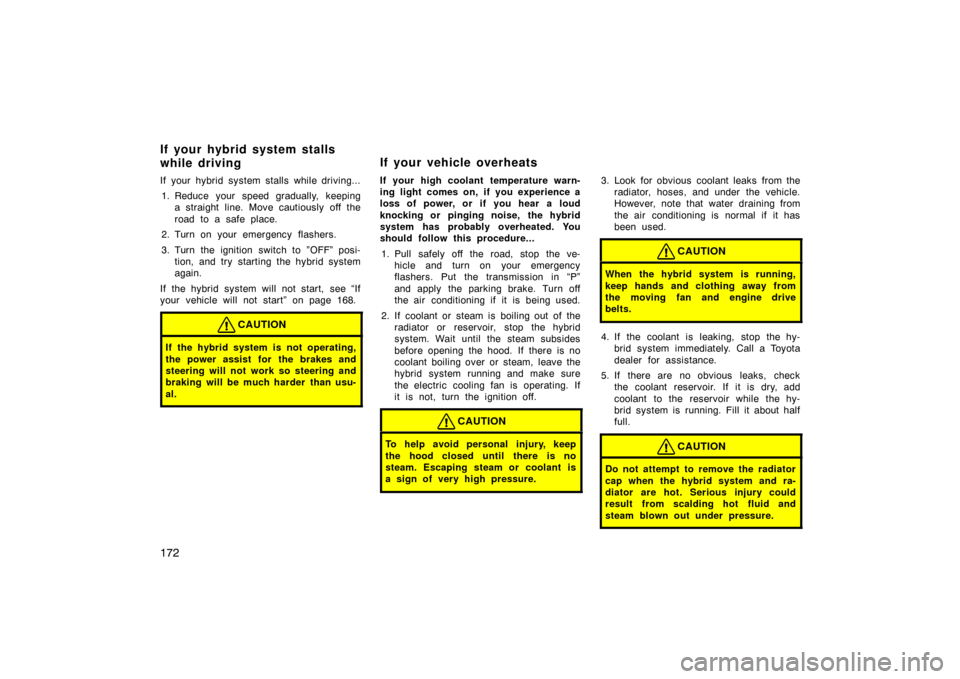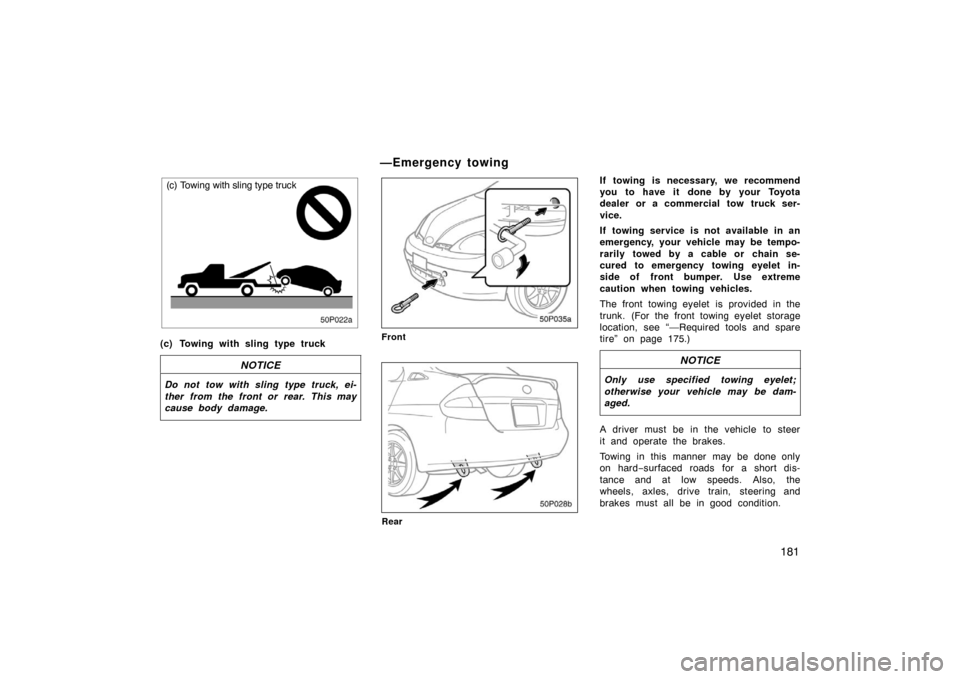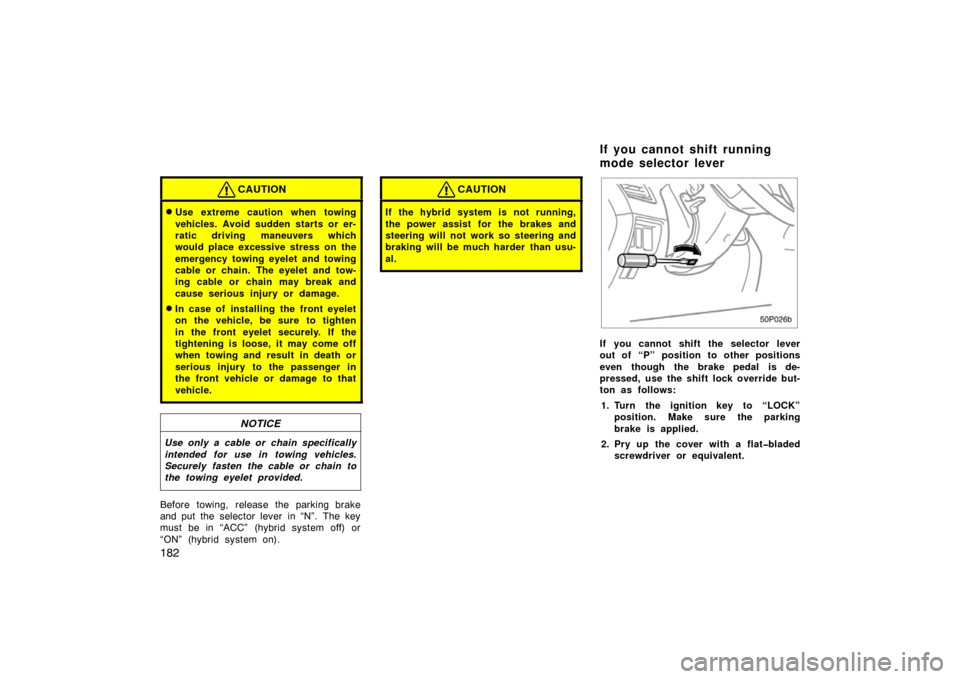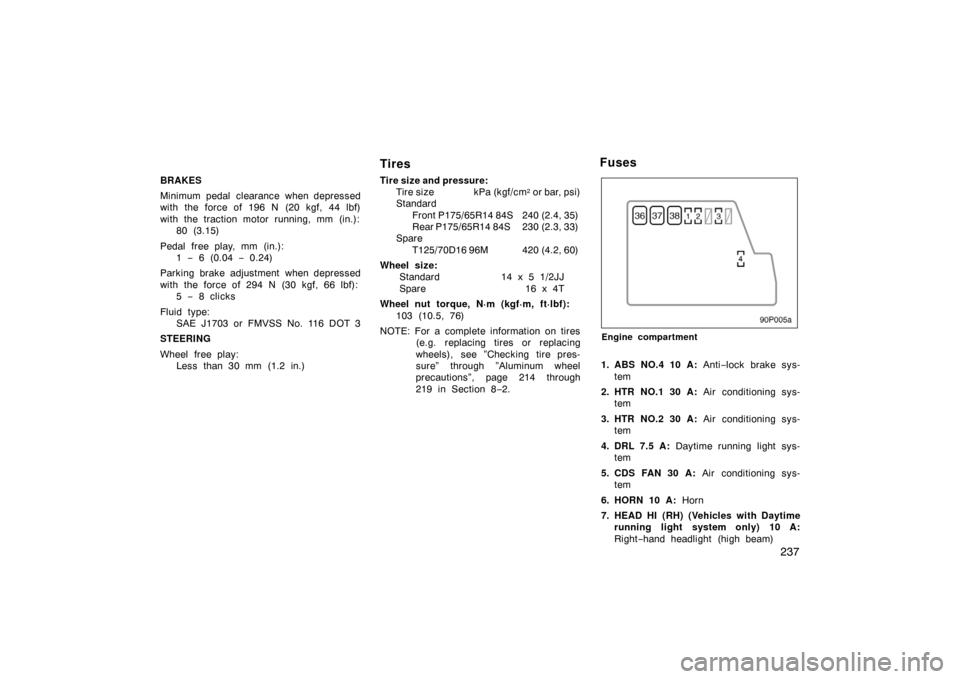Page 185 of 258

172
If your hybrid system stalls while driving...1. Reduce your speed gradually, keeping a straight line. Move cautiously off the
road to a safe place.
2. Turn on your emergency flashers.
3. Turn the ignition switch to ”OFF” posi- tion, and try starting the hybrid system
again.
If the hybrid system will not start, see “If
your vehicle will not start” on page 168.
CAUTION
If the hybrid system is not operating,
the power assist for the brakes and
steering will not work so steering and
braking will be much harder than usu-
al.
If your high coolant temperature warn-
ing light comes on, if you experience a
loss of power, or if you hear a loud
knocking or pinging noise, the hybrid
system has probably overheated. You
should follow this procedure... 1. Pull safely off the road, stop the ve- hicle and turn on your emergency
flashers. Put the transmission in “P”
and apply the parking brake. Turn off
the air conditioning if it is being used.
2. If coolant or steam is boiling out of the radiator or reservoir, stop the hybrid
system. Wait until the steam subsides
before opening the hood. If there is no
coolant boiling over or steam, leave the
hybrid system running and make sure
the electric cooling fan is operating. If
it is not, turn the ignition off.
CAUTION
To help avoid personal injury, keep
the hood closed until there is no
steam. Escaping steam or coolant is
a sign of very high pressure.
3. Look for obvious coolant leaks from theradiator, hoses, and under the vehicle.
However, note that water draining from
the air conditioning is normal if it has
been used.
CAUTION
When the hybrid system is running,
keep hands and clothing away from
the moving fan and engine drive
belts.
4. If the coolant is leaking, stop the hy-brid system immediately. Call a Toyota
dealer for assistance.
5. If there are no obvious leaks, check the coolant reservoir. If it is dry, add
coolant to the reservoir while the hy-
brid system is running. Fill it about half
full.
CAUTION
Do not attempt to remove the radiator
cap when the hybrid system and ra-
diator are hot. Serious injury could
result from scalding hot fluid and
steam blown out under pressure.
If your hybrid system stalls
while driving If your vehicle overheats
Page 194 of 258

181
50p022a
(c) Towing with sling type truck
(c) Towing with sling type truck
NOTICE
Do not tow with sling type truck, ei-
ther from the front or rear. This may
cause body damage.
50p035a
Front
50p028b
Rear
If towing is necessary, we recommend
you to have it done by your Toyota
dealer or a commercial tow truck ser-
vice.
If towing service is not available in an
emergency, your vehicle may be tempo-
rarily towed by a cable or chain se-
cured to emergency towing eyelet in-
side of front bumper. Use extreme
caution when towing vehicles.
The front towing eyelet is provided in the
trunk. (For the front towing eyelet storage
location, see “—Required tools and spare
tire” on page 175.)
NOTICE
Only use specified towing eyelet;
otherwise your vehicle may be dam-
aged.
A driver must be in the vehicle to steer
it and operate the brakes.
Towing in this manner may be done only
on hard− surfaced roads for a short dis-
tance and at low speeds. Also, the
wheels, axles, drive train, steering and
brakes must all be in good condition.
—Emergency towing
Page 195 of 258

182
CAUTION
�Use extreme caution when towing
vehicles. Avoid sudden starts or er-
ratic driving maneuvers which
would place excessive stress on the
emergency towing eyelet and towing
cable or chain. The eyelet and tow-
ing cable or chain may break and
cause serious injury or damage.
�In case of installing the front eyelet
on the vehicle, be sure to tighten
in the front eyelet securely. If the
tightening is loose, it may come off
when towing and result in death or
serious injury to the passenger in
the front vehicle or damage to that
vehicle.
NOTICE
Use only a cable or chain specifically
intended for use in towing vehicles.
Securely fasten the cable or chain to
the towing eyelet provided.
Before towing, release the parking brake
and put the selector lever in “N”. The key
must be in “ACC” (hybrid system off) or
“ON” (hybrid system on).
CAUTION
If the hybrid system is not running,
the power assist for the brakes and
steering will not work so steering and
braking will be much harder than usu-
al.
50p026b
If you cannot shift the selector lever
out of “P” position to other positions
even though the brake pedal is de-
pressed, use the shift lock override but-
ton as follows:1. Turn the ignition key to “LOCK” position. Make sure the parking
brake is applied.
2. Pry up the cover with a flat�bladed screwdriver or equivalent.
If you cannot shift running
mode selector lever
Page 209 of 258

196
INSIDE THE VEHICLE
Items listed below should be checked
regularly, e.g. while performing periodic
services, cleaning the vehicle, etc.
Lights
Make sure the headlights, stop lights, tail
lights, turn signal lights, and other lights
are all working. Check headlight aim.
Service reminder indicators and warning
buzzers
Check that all service reminder indicators
and warning buzzers function properly.
Steering wheel
Be alert for changes in steering condition,
such as hard steering or strange noise.
Seats
Check that all front seat controls such as
seat adjusters, seatback recliner, etc. op-
erate smoothly and that all latches lock
securely in any position. Check that the
head restraint move up and down smooth-
ly and that the locks hold securely in any
latched position. For folding−down rear
seatbacks, check that the latches lock se-
curely. Seat belts
Check that the seat belt system such as
buckles, retractors and anchors operate
properly and smoothly. Make sure the belt
webbing is not cut, frayed, worn or dam-
aged.
Accelerator pedal
Check the pedal for smooth operation and
uneven pedal effort or catching.
Brake pedal
Check the pedal for smooth operation and
that the pedal has the proper clearance.
Check the brake booster function.
Brakes
At a safe place, check that the brakes do
not pull to one side when applied.
Parking brake
Check that the pedal has the proper travel
and that, on a safe incline, your vehicle
is held securely with only the parking
brake applied.
Hybrid transaxle ”Park” mechanism
Check the lock release button of the se-
lector lever for proper and smooth opera-
tion. On a safe incline, check that your
vehicle is held securely with the selector
lever in ”P” position and all brakes re-
leased.
IN THE ENGINE COMPARTMENT
Items listed below should be checked
from time to time, e.g. each time when
refueling.
Washer fluid
Make sure there is sufficient fluid in the
tank. See page 225 in Section 8
−3 for
additional information.
Coolant level
Make sure the coolant level is between
the ”FULL” and ”LOW” lines on the see −
through reservoir when the hybrid system
is cold. See page 210 in Section 8 −2 for
additional information.
Radiator, condenser and hoses
Check that the front of the radiator and
condenser are clean and not blocked with
leaves, dirt, or insects. See page 211 in
Section 8 −2 for additional information.
Page 250 of 258

237
BRAKES
Minimum pedal clearance when depressed
with the force of 196 N (20 kgf, 44 lbf)
with the traction motor running, mm (in.):80 (3.15)
Pedal free play, mm (in.): 1 − 6 (0.04 − 0.24)
Parking brake adjustment when depressed
with the force of 294 N (30 kgf, 66 lbf): 5 − 8 clicks
Fluid type: SAE J1703 or FMVSS No. 116 DOT 3
STEERING
Wheel free play: Less than 30 mm (1.2 in.)
Tires
Tire size and pressure:Tire size kPa (kgf/cm2 or bar, psi)
Standard
Front P175/65R14 84S 240 (2.4, 35)
Rear
P175/65R14 84S 230 (2.3, 33)
Spare
T125/70D16 96M 420 (4.2, 60)
Wheel size: Standard 14 x 5 1/2JJ
Spare 16 x 4T
Wheel nut torque, N·m (kgf·m, ft·lbf): 103 (10.5, 76)
NOTE: For a complete information on tires (e.g. replacing tires or replacing
wheels), see ”Checking tire pres-
sure” through ”Aluminum wheel
precautions”, page 214 through
219 in Section 8 −2.
90p005a
Engine compartment
1. ABS NO.4 10 A: Anti−lock brake sys-
tem
2. HTR NO.1 30 A: Air conditioning sys-
tem
3. HTR NO.2 30 A: Air conditioning sys-
tem
4. DRL 7.5 A: Daytime running light sys-
tem
5. CDS FAN 30 A: Air conditioning sys-
tem
6. HORN 10 A: Horn
7. HEAD HI (RH) (Vehicles with Daytime running light system only) 10 A:
Right −hand headlight (high beam)
Fuses